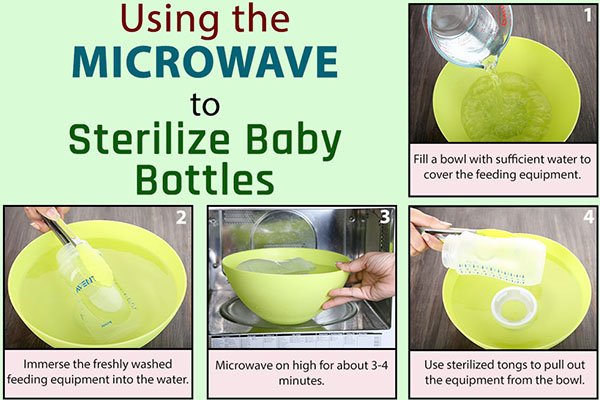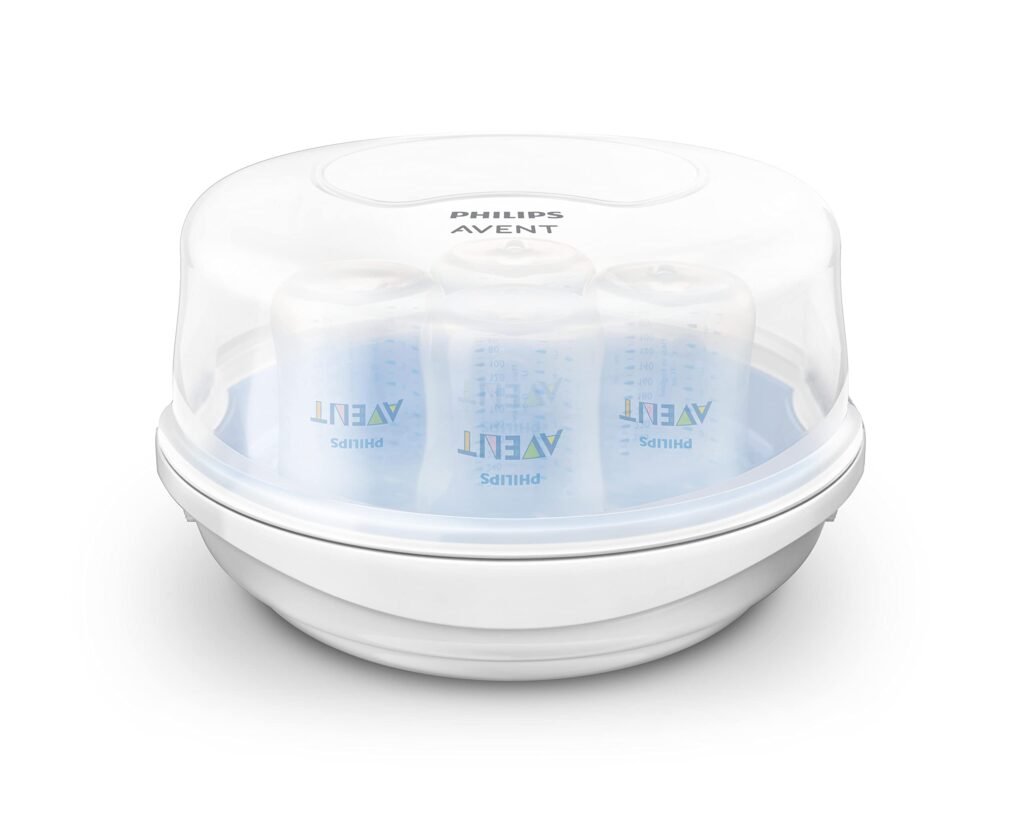
If you’re a parent wondering about the effectiveness of using a microwave for sterilizing your baby bottles, look no further. In this article, we will explore the topic of microwave sterilization of baby bottles and discuss its safety and efficiency. So, can you use a microwave for sterilizing your baby bottles? Let’s find out.
Overview of Microwave Sterilization
Microwave sterilization offers a convenient and effective way to ensure that your baby’s bottles are free from harmful bacteria and germs. This method involves using the power of the microwave to create steam, which effectively eliminates pathogens and keeps your little one safe and healthy. In this comprehensive article, we will explore what microwave sterilization is, its advantages and disadvantages, how to properly prepare baby bottles for sterilization, the step-by-step process of microwave sterilization, important safety precautions to keep in mind, its effectiveness, a comparison with other sterilization methods, common mistakes to avoid, and tips for safe and efficient sterilization. By the end of this article, you will have all the information you need to confidently use your microwave for sterilizing baby bottles.
What is Microwave Sterilization?
Microwave sterilization is the process of using microwave energy to heat water and create steam that effectively kills bacteria and germs on baby bottles. The high temperatures achieved in the microwave generate steam, which, when properly utilized, can eliminate up to 99.9% of harmful pathogens, ensuring that your baby’s bottles are hygienic and safe to use. This method is quick, convenient, and easy to do, making it a popular choice among busy parents.

This image is property of www.niniobaby.com.
Advantages of Microwave Sterilization
There are several advantages to using the microwave sterilization method for baby bottles. Firstly, it is a time-efficient process, allowing you to sterilize multiple bottles in just a matter of minutes. This can be particularly beneficial for parents who need to prepare bottles on the go or have limited time at their disposal. Furthermore, the microwave sterilization method is cost-effective since it only requires water and a microwave, eliminating the need for expensive sterilizing equipment. Additionally, microwave sterilization can effectively eliminate bacteria and germs, providing you with peace of mind knowing that your baby’s bottles are clean and safe for use.
Disadvantages of Microwave Sterilization
While microwave sterilization has many advantages, it is essential to consider its disadvantages as well. One of the main drawbacks is the need for careful attention to avoid overheating. If bottles are overheated, they can become warped, melted, or even explode, posing a safety risk. Additionally, microwave sterilization may not be suitable for all types of baby bottles, as some materials may not withstand the high temperatures generated in the microwave. It is crucial to ensure that your bottles are labeled as microwave-safe to prevent any potential damage. Lastly, microwave sterilization may not be as effective against certain stubborn bacteria or viruses compared to other sterilization methods.

This image is property of img.emedihealth.com.
Preparing Baby Bottles for Microwave Sterilization
Before starting the microwave sterilization process, it is crucial to properly prepare your baby bottles. Follow these steps to ensure that your bottles are ready for sterilization:
Choosing the Right Bottles
When selecting bottles for microwave sterilization, it is essential to choose ones that are labeled as microwave-safe. These bottles are specifically designed to withstand the high temperatures generated in the microwave without warping or melting. Avoid using bottles with metal or silver parts, as these can cause sparks in the microwave and pose a safety hazard.
Cleaning and Rinsing
Before sterilizing your baby bottles, thoroughly clean them with warm soapy water. Pay special attention to the nipple and cap, ensuring that no milk residue remains. Rinse the bottles thoroughly to remove any soap residue, as this can affect the taste and safety of the milk.
Assembling the Bottles
After cleaning and rinsing the bottles, assemble them with the nipple and cap, ensuring a snug fit. This will prevent any parts from getting lost during the sterilization process.
Removing Nipple and Cap
Before placing the bottles in the microwave, it is essential to remove the nipple and cap. These should be sterilized separately, as they can be damaged or deformed if exposed to high temperatures in the microwave.
Checking for Microwave Safety
Before proceeding with sterilization, carefully check the manufacturer’s instructions to ensure that your bottles are suitable for microwave sterilization. Certain bottles may have specific guidelines or warnings that need to be followed to prevent damage or injury.
The Process of Microwave Sterilization
Microwave sterilization is a straightforward process that can be followed by anyone. Here are the step-by-step instructions to effectively sterilize your baby bottles using a microwave:
Step 1: Adding Water
Start by adding the appropriate amount of water to the microwave-safe sterilizing container. Consult the bottle manufacturer’s instructions for the recommended water level.
Step 2: Placing Bottles in the Microwave
Carefully place the assembled bottles into the sterilizing container. Ensure that they are spaced apart and not touching each other to allow for even steam distribution.
Step 3: Setting the Microwave Power and Time
Set the microwave to the appropriate power level and time recommended by the bottle manufacturer. Follow these instructions carefully to prevent overheating or causing damage to the bottles.
Step 4: Cooling and Draining the Bottles
Once the sterilization process is complete, carefully remove the sterilizing container from the microwave. Allow the bottles to cool before handling them. After they have cooled down, pour out any remaining water from the bottles, and they are ready to use.

This image is property of i.ytimg.com.
Safety Precautions
While microwave sterilization can be a safe method if proper precautions are taken, it is essential to be aware of the potential risks involved. Follow these safety precautions to ensure a safe and successful sterilization process:
Using Microwave-Safe Bottles
Always use bottles that are specifically labeled as microwave-safe. These bottles are designed to withstand the high temperatures and steam generated during the sterilization process without warping, melting, or posing any safety hazards.
Avoiding Metal or Silver Parts
Do not use bottles with metal or silver parts in the microwave. Metal can cause sparks and potentially damage the microwave, while silver parts may tarnish or become damaged.
Bottle Warping and Melting
Take care not to overheat the bottles, as this can cause warping or melting. Follow the recommended power and time settings provided by the bottle manufacturer to prevent any damage.
Steam Burns
After sterilization, the bottles and water can be extremely hot. Use oven mitts or heat-resistant gloves when handling hot bottles or draining the water to avoid steam burns.
Avoiding Overheating
Never leave the bottles in the microwave for longer than the recommended sterilization time. Overheating can lead to bottle damage, potentially causing them to warp, melt, or explode.
Proper Ventilation
Ensure that the sterilizing container has proper ventilation to allow steam to escape. This prevents pressure build-up and reduces the risk of bottles exploding due to excessive steam.
Effectiveness of Microwave Sterilization
Microwave sterilization has been shown to effectively eliminate bacteria and germs, making it a reliable method for keeping baby bottles hygienic. By following the correct procedures, microwave sterilization can eliminate up to 99.9% of harmful pathogens, giving you peace of mind that your baby is protected from potential infections.
Eliminating Bacteria and Germs
The high temperatures achieved during microwave sterilization generate steam, which is proven to effectively kill bacteria and germs. This process ensures that your baby’s bottles are free from harmful pathogens that can cause illnesses.
Effectiveness against Specific Pathogens
Microwave sterilization has been tested and found to be effective against a wide range of bacteria and germs, including common pathogens such as E. coli and Salmonella. However, it is important to note that this method may not be as effective against certain viruses or stubborn bacteria, such as those that cause thrush or some strains of the norovirus.
Considerations for Effective Sterilization
To ensure the effectiveness of microwave sterilization, it is crucial to carefully follow the manufacturer’s instructions and use bottles that are specifically labeled as microwave-safe. Additionally, maintaining a clean microwave and regularly checking for any damage to the bottles will contribute to efficient sterilization.

This image is property of cdn2.momjunction.com.
Microwave Sterilization vs. Other Methods
While microwave sterilization is a popular choice, there are alternative methods available for sterilizing baby bottles. Here is a comparison of microwave sterilization with two other commonly used methods:
Comparison with Boiling Method
Boiling baby bottles in a pot of water is an effective sterilization method. However, it can be time-consuming, requiring a large pot and frequent supervision. Microwave sterilization, on the other hand, is quicker and more convenient, making it a preferred choice for busy parents.
Comparison with Electric Steam Sterilizers
Electric steam sterilizers are specifically designed for bottle sterilization and offer ease of use. However, they can be costly, require specific equipment, and take up valuable counter space. Microwave sterilization, in contrast, requires only a microwave and a suitable sterilizing container, making it a more affordable and space-saving option.
Advantages and Disadvantages
Each sterilization method has its own advantages and disadvantages. Microwave sterilization is quick, cost-effective, and convenient. However, it can be less effective against specific pathogens and requires caution to prevent bottle damage. Ultimately, the choice between methods will depend on individual preferences and needs.
Common Mistakes to Avoid
To ensure the success and safety of microwave sterilization, it is important to avoid these common mistakes:
Overfilling Bottles with Water
Avoid overfilling the bottles with water, as this can cause excessive steam and increase the risk of bottles warping, melting, or exploding. Follow the manufacturer’s instructions for the recommended water level.
Using Damaged or Cracked Bottles
Using damaged or cracked bottles can compromise the effectiveness of sterilization and pose a safety risk. Inspect your bottles regularly for any signs of damage and replace them as necessary.
Ignoring Manufacturer Instructions
The manufacturer’s instructions provide important guidelines for safe and effective sterilization. Always read and follow these instructions carefully, as they are specifically tailored to the specific bottle brand and model.
Leaving Bottles Uncovered
After sterilization, it is important to cover the bottles with their caps or store them in a clean, covered container to prevent contamination. Leaving the bottles uncovered can expose them to airborne bacteria and germs.

This image is property of Amazon.com.
Tips for Safe and Efficient Microwave Sterilization
To ensure safe and efficient microwave sterilization, consider following these helpful tips:
Maintaining a Clean Microwave
Regularly clean your microwave to remove any food residue, spills, or stains. A clean microwave ensures optimal sterilization and prevents any unwanted odors or tastes from transferring to the bottles.
Using Microwave Turntable
If your microwave has a turntable, ensure that it is in proper working condition and rotating freely. This allows for even distribution of steam and heat, ensuring that all areas of the bottles are sterilized effectively.
Finding the Right Power and Time Settings
Carefully read the manufacturer’s instructions to determine the recommended power and time settings for your specific bottles. Adjusting these settings can affect the efficiency and safety of the sterilization process.
Proper Handling of Hot Bottles
After sterilization, allow the bottles to cool before handling them. Use oven mitts or heat-resistant gloves to protect your hands from heat and potential steam burns.
Alternatives to Microwave Sterilization
While microwave sterilization is a popular choice, several alternative methods can be used to sterilize baby bottles effectively. Consider the following options:
Cold Water Sterilization
Cold water sterilization involves using a sterilizing solution, such as bleach or specially formulated tablets, in cold water to kill bacteria and germs. This method requires longer soaking times but can be suitable for parents who don’t have access to a microwave or prefer not to use one.
Chemical Sterilizing Solutions
Chemical sterilizing solutions, such as sterilizing tablets or liquids, are commonly used to sterilize baby bottles. These solutions contain powerful germ-killing agents that effectively eliminate bacteria and germs. However, it is essential to follow the manufacturer’s instructions carefully and rinse the bottles thoroughly after sterilization to ensure the removal of any chemical residues.
Dishwasher Sterilization
If your dishwasher has a sterilization feature, it can be a convenient method for sterilizing baby bottles. This method involves using high-temperature water and steam to kill bacteria and germs. However, it is important to ensure that your dishwasher is in good working condition and follow the manufacturer’s instructions for proper loading and cycle selection.
Conclusion
Microwave sterilization provides a quick, convenient, and cost-effective way to ensure that your baby’s bottles are free from harmful bacteria and germs. By following the proper procedures, choosing microwave-safe bottles, and taking necessary safety precautions, you can confidently use your microwave for sterilizing baby bottles. Remember to carefully read the manufacturer’s instructions, avoid common mistakes, and utilize the tips provided for safe and efficient sterilization. With microwave sterilization, you can provide your little one with clean and hygienic bottles, promoting their health and well-being.


